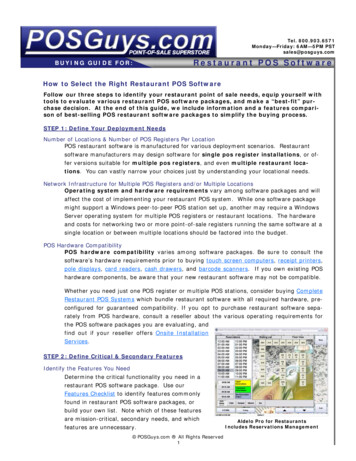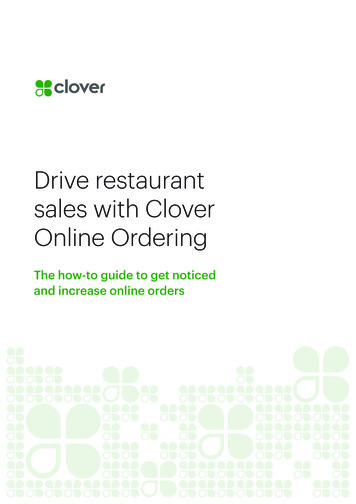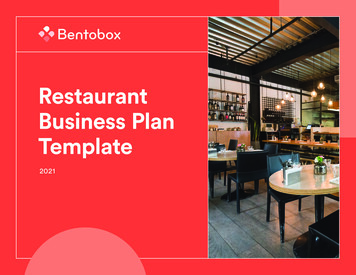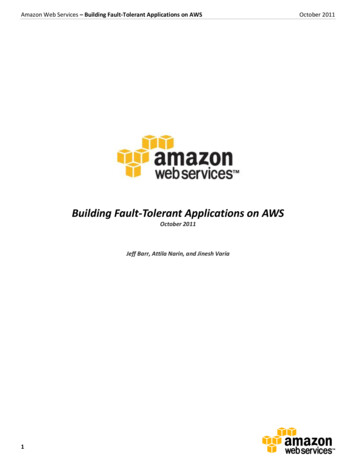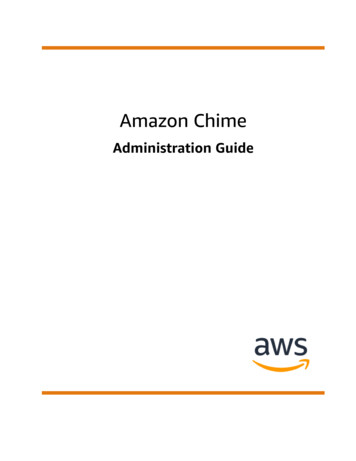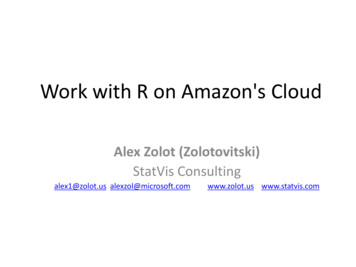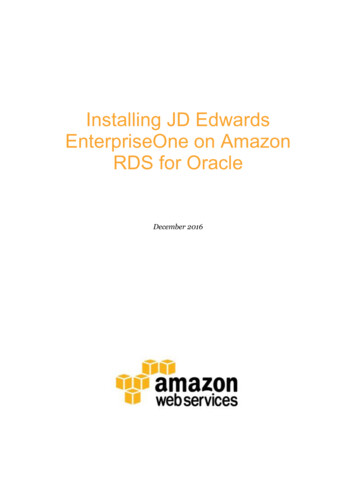
Transcription
KSA RESTAURANT SECTORTurning meals into profitsRestaurant operators better positioned in KSA than food producersInitiate on Herfy with a HOLD28th April 2013Coverage Universe HIGH AFFINITY FOR MEAT MAKES SAUDI ARABIA AN ATTRACTIVE QSR MARKETHerfyRecommendationHOLDTarget Price (LC)119.10P/E 1317.6EV/EBITDA 1313.41401301201101009080TASIHefyAlmaraiSector CoverageAsjad Yahya, CFA 9714 3199 768ayahya @shuaa.comHigh earning capacity, a young, fast growing population base and long stretches of extremely hot weather,which encourage the tendency to seek entertainment indoors, make Saudi Arabia a very attractive market for theQuick Service Restaurant (QSR) industry. This is further supported by a relatively high affinity for meat in thecountry, with consumption per person per annum in KSA at 52.3 kilos, well ahead of the global average of 38.7kilos. Moreover, while Saudi Arabia ranks favorably in terms of market share of chained consumer foodservicewithin a regional context, a comparison with developed markets suggests there is room for further growth. Thus,given the attractive fundamentals of the QSR industry in Saudi Arabia, all major food chains, ranging from PizzaHut to McDonald’s, currently have significant presence in the country, with new names continuing to enter themarket each year. In addition to the restaurant chains, the strong underlying fundamentals of the sector are alsostarting to attract sophisticated institutional investors, with the Carlyle Group acquiring a 42% stake in Saudibased Alamar Foods in 2011. Alamar acts as a master franchise operator of Domino’s Pizza and Wendy’shamburgers in the MENA region.NON-CRITICAL NATURE OF INDUSTRY HELPS AVOID PRICE REGULATIONSThe consumer sector is widely seen as a key means of capitalizing on the attractive demographics in KSA (rapidlygrowing population with high earning capacity). However, following the Arab Spring in particular, the country’sgovernment has started relying on food price controls as a key means of appeasing its citizens. The mostsignificant example in this regard is that of the dairy industry, with the government reversing product priceincreases by Almarai in both 2011 and 2012. In contrast, fast food is not considered a “necessity”, despite itsgrowing popularity and as such the industry remains free from pricing regulations. Moreover, QSR operatorsenjoy the ability to enhance the overall pricing of their portfolio without raising list prices by introducing new“value added” product ranges. This can either be in the form of variations of existing offerings, such as the “MegaMac” burger from McDonald’s (which is the upsized version of the Big Mac) and the Triple Whopper by BurgerKing, or a completely new, relatively expensive line introduced for a limited time (the “Turkish” burger currentlybeing offered by McDonald’s is a good example). In fact, we feel that the ability to adopt this strategy is a keyreason why Herfy has managed to increase yields at its restaurants from SAR 2.7mn in 2010 to SAR 3.5mn lastyear, despite the fact that it has not increased product prices over the past 3-4 years.HERFY OFFERS EXPOSURE TO THE ATTRACTIVE QSR SECTOR, HOWEVER SHARES FULLY PRICEDHerfy is the dominant local QSR operator in Saudi Arabia, benefiting from one of the widest network ofrestaurants in the country and ranking as one of the top two burger fast food companies in KSA by sales volume.Moreover, the company intends to solidify its position as the leading local player with an aggressive expansionplan that envisions opening of 20-25 new stores every year for the foreseeable future against a total of 200 storesat the end of 2012. In addition, the company operates bakeries & bakery shops, a rusk factory and a meat factoryin Saudi Arabia and is increasing its presence in the wider region through franchised restaurants (12 stores intotal at this stage in UAE, Kuwait and Bahrain). As such, the company offers investors a well-balanced means ofgaining exposure to the attractive QSR sector in Saudi Arabia. However, following the 32% run-up in the pasttwelve months (15% YTD), we feel that the growth prospects of the company are already factored into its stockprice. Our DCF-based analysis of the company suggests a fair value of SAR 119.10/share, translating into 6.3%upside potential from the recent closing price of SAR 112.00/share. Peer-based comparison also supports ouranalysis, with relative valuation suggesting a fair value estimate of SAR 113.25/share, based on average 2013 P/Eand EV/EBITDA industry multiples. We thus initiate coverage on Herfy with a HOLD recommendation and aTarget Price of SAR 119.10/share.Taher Safieddine, CFACompany 9714 3199 785Herfytsafieddine@shuaa.comPrice (LC)RecommendationTarget Price (LC)%upside/(downside)112.00HOLD119.106.3%
KSA Restaurant SectorTable of ContentsTable of Contents . 2KSA Quick Service Restaurant sector snapshot . 3An attractive market for QSR industry . 3KSA largest market in the region; data suggests further room for growth . 4Non-critical nature of industry means little, if any regulations on pricing . 5Regional listed QSR companies outperform peers . 6Herfy Food Services Company (Herfy)The story in charts . 8Valuation . 9DCF preferred valuation methodology . 9Relative valuation supports our DCF-based Target Price .10Solidifying position as largest local player . 12A key player in the KSA fast food industry.12Enjoying competitive cost advantage .13Expansion plans to refocus on restaurant business from 2013 .13Financial Outlook . 15Restaurant business to drive top line growth .15Margins to come under pressure in near term, improve over the longer term .16Healthy EBITDA growth; franchise income to rise faster, but contribution will remain limited .17Capex peaking in 2012-2013; debt gearing to remain low .17Net income growth to outpace revenue growth; dividend payout ratio to remain high .18Financial Statements . 19April 28th, 20132
KSA Restaurant SectorKSA Quick Service Restaurant sector snapshotAn attractive market for QSR industryHigh earning capacity, a young, fast growing population base and long stretches of extremely hot weather, whichencourage the tendency to seek entertainment indoors, make Saudi Arabia a very attractive market for the Quick ServiceRestaurants (QSR) industry. This is further supported by a relatively high affinity for meat in the country, with consumptionper person per annum in KSA well ahead of the global average. In fact, in its Q1-13 results conference call, Almarai indicatedthat it has witnessed a decline in demand for cheese and butter in Saudi Arabia, with the segment recording a YoY declinein revenues in the country. The company attributed this reduction in significant part to the growing consumption of fastfood, which in turn has lowered demand for cheese in particular within households. Given Almarai’s position as the largestdairy company in KSA, this serves as a strong positive indicator for the health of the QSR industry in the country.Key consumers of meat (ranking out of 177 countries)RankCountryMeat consumption per person/year (kg)1Luxembourg136.52USA125.43Australia115.74New Zealand115.75Spain110.26French 0Bahamas98.111Denmark97.812Kuwait97.413Saint i Arabia52.3World Average38.7Source: FAO, The Economist, SHUAA CapitalApril 28th, 20133
KSA Restaurant SectorKSA largest market in the region; data suggests further room for growthIndustry data indicates that Saudi Arabia is the largest fast food market in the region. Currently estimated around the USD4bn mark, the QSR market size in the country is projected to grow to USD 4.5bn by 2015 by Euromonitor, translating into a2013-2015 CAGR of 6%. The Carlyle Group similarly projects QSR sales at a CAGR (2010-2014) of 5% in the Kingdom.Breakdown of QSR market share in GCCOthers,10-20%UAE,20-25%KSA,60-65%Source: Gulf Organization for Industrial Consulting, SHUAA CapitalMarket penetration data for the QSR industry in Saudi Arabia also supports expectations of further growth in the sector.While the country ranks favorably in a regional context in terms of market share of chained consumer foodservice, acomparison with developed markets suggests there is room for further growth.Chained foodservice as % of total foodservice outletsChained foodservice as % of total foodservice 020152010105-CanadaUSATaiwanSource: Euromonitor, SHUAA CapitalNorwayUKSaudi ArabiaCanadaUSAJapanFinalandUKSaudi ArabiaSource: Euromonitor, SHUAA CapitalGiven the attractive fundamentals of the QSR industry in Saudi Arabia, all major food chains, ranging from Pizza Hut toMcDonald’s, currently have significant presence in the country, with new names continuing to enter the market each year.In addition to the restaurant chains, the strong underlying fundamentals of the sector are also starting to attractsophisticated institutional investors, with the Carlyle Group acquiring a 42% stake in Saudi-based Alamar Foods in 2011.Alamar acts as a master franchise operator of Domino’s Pizza and Wendy’s hamburgers in the MENA region.April 28th, 20134
KSA Restaurant SectorNon-critical nature of industry means little, if any regulations on pricingThe consumer sector is widely seen as a key means of capitalizing on the attractive demographics in KSA (rapidly growingpopulation with high earning capacity). However, following the Arab Spring in particular, the country’s government hasstarted relying on food price controls as a key means of appeasing its citizens. The most significant example in this regard isthat of the dairy industry, with government reversing product price increases by Almarai in both 2011 and 2012. In fact,these price caps serve as a key reason for our HOLD recommendation on the stock. In contrast, fast food is not considered a“necessity”, despite its growing popularity, and as such the industry remains free from pricing regulations. The impact of thisdifference is aptly demonstrated by the trend for gross margins at Almarai and Herfy - two key players in the Saudi dairy andburger fast food industries, respectively - over the past few years. While both companies have witnessed a downward trend,mainly due to rising raw material costs, the decline has been much more significant for Almarai, as it faced greater difficultyin passing on the higher costs to consumers.Herfy’s gross margins more stable than that of lmaraiSource: Herfy, AlmaraiNote that despite the absence of direct regulatory restrictions, fast food companies in KSA have generally avoided raisinglist prices due to ever-increasing competition. Instead, companies continually introduce new “value added” product rangesto enhance the overall pricing of their portfolio. This can either be in the form of variations of existing offerings, such as the“Mega Mac” burger from McDonald’s (which is the upsized version of the Big Mac) and the Triple Whopper by Burger King,or a completely new, relatively expensive line introduced for a limited time (the “Turkish” burger currently being offered byMcDonald’s is a good example). In fact, we feel that the ability to adopt this strategy is a key reason why Herfy has managedto increase yields at its restaurants despite the fact that it has not increased product prices over the past 3-4 years.Herfy: restaurant yields increasing despite absence of price ,000500201020112012Revenue per restaurant (SAR'000)Source: HerfyApril 28th, 20135
KSA Restaurant SectorBig Mac index suggests fast food is cheap in Saudi ArabiaThe Economist’s Big Mac index, which maps the burger’s price in various countries against their respective GDP/capita toestimate Purchasing Power Parity, interestingly suggests that fast food is cheaply priced in Saudi Arabia, both in a regionaland a global context. Although the tool is generally utilized as an informal means to assess which countries’ currencies areover or undervalued, the use of the Big Mac price alone for this purpose provides good insight into the pricing structurewithin the Saudi fast food industry.Big Mac index suggests fast food is cheap in KSA9NorwayBig Mac price 40,00060,00080,000GDP per capita (USD'000) - 2011100,000Source: The EconomistThe attractive pricing of fast food relative to the earning power in Saudi Arabia further supports expectations of healthygrowth in the sector, with the possibility of upward revision in price another potential catalyst for boosting revenues.Regional listed QSR companies outperform peersThe GCC markets include two prominent listed QSR companies, namely Herfy and Kuwait-based Americana. Bothcompanies have outpaced their regional peers in the wider food sector. The greater pricing power enjoyed by thesecompanies, coupled with lower regulatory risk, is likely to have been a key catalyst for this outperformance.QSR sector stocks outperforming y0.0AmericanaTTM returns (%)30.0-18.1-30.0Source: Bloomberg, SHUAA CapitalApril 28th, 20136
KSA Restaurant SectorBloombergHerfy ABReuters6002.SEHerfy Food Services CompanyPremier player in an attractive industry, but prospects priced in28th April 2013112.00Current stock price (SAR)Recommendation: HOLDCurrent Price:SAR 112.00Country:Saudi Arabia76.36-118.0052-week range (SAR)YTD performance15.2%Target PriceSAR 119.10Sector:ConsumerNumber of shares 2.1Free Float (%)Market Cap (SAR mn)3,696Market Cap (USD mn)9863.4%Div. Yld 2013P1401301201101009080TASIHefyLEADING PLAYER IN KSA FAST FOOD INDUSTRYHerfy is the dominant local QSR operator in Saudi Arabia, benefiting from one of the widest network ofrestaurants in the country and ranking as one of the top two burger fast food companies in KSA by salesvolume. Moreover, the company intends to solidify its position as the leading local player with an aggressiveexpansion plan that envisions opening of 20-25 new stores every year for the foreseeable future against a totalof 200 stores at the end of 2012. In addition, the company operates bakeries & bakery shops, a rusk factory and ameat factory in Saudi Arabia and is increasing its presence in the wider region through franchised restaurants(12 stores in total at this stage in UAE, Kuwait and Bahrain). Herfy remains 100% owned by Saudi nationals, a factthat helps it tap into strong patriotism in KSA. In fact, the brand is heavily promoted as 100% local-owned, withanecdotal evidence indicating that a significant portion of Saudi customers have developed strong loyalty tothe brand due to this factor.ENJOYING COMPETITIVE COST ADVANTAGEHerfy enjoys a competitive edge over its peers, particularly international chains, in terms of its cost structure.This advantage is driven by a number of factors, the most significant of which include: 1) vertical integration ofsupply chain, with all meat requirements fulfilled by Herfy’s own meat processing plant and a significant portionof bread requirement through its bakeries and 2) absence of royalty fees, which local arms of internationalchains have to pay. As a result, the company is able to attractively price its product range withoutcompromising on quality. In fact, our discussion with representatives of McDonald’s in KSA indicates that one ofthe key reasons the international fast food chain is forced to maintain relatively low prices (even by regionalstandards) is the pricing structure at Herfy.HEALTHY CAPEX PROGRAM TO TRANSLATE INTO STRONG GROWTHHerfy witnessed a marked increase in capital expenditure in 2012 (SAR 158mn vs. SAR 103mn in 2011) as a resultof investment on a new bakery plant at an estimated cost of c. SAR 120mn, which has expanded total bakerycapacity at the company by 5 times. The current year is anticipated to record a similar sized capital expenditure(SAR 150mn) as the company opens 20 new large restaurants. Moreover, Herfy’s growth plan calls for 20-25 newstore openings every year over the foreseeable future. We thus expect the combination of 1) operationalimprovement in existing facilities (particularly in restaurants that opened in recent years and the new bakeryplant) and 2) continued healthy capital expenditure (focused mainly on restaurant expansion) to translate intohealthy 2012-2017 CAGRs of 17.9% and 19.0% for revenues and net income, respectively. For 2013 in particular,we project top line growth of 20.5% and net income growth of 15.7% YoY.Sector CoverageAsjad Yahya, CFA 9714 3199 768ayahya @shuaa.comTaher Safieddine, CFA 9714 3199 785tsafieddine @shuaa.comApril 28th, 2013INITIATING COVERAGE ON HERFY WITH HOLD AND TP OF SAR 119.10/SHAREAlthough we like Herfy’s business model and the segment of the overall consumer sector that it operates in, wefeel that the market has largely factored in the growth prospects of the company (up 32% TTM and 15% YTD).Our TP of SAR 119.10/share is based on DCF analysis covering the 2013-2017 period (WACC: 11%, TerminalGrowth: 3.0%). We have also conducted a relative valuation exercise as a sanity check, which yields a slightlylower fair value estimate of SAR 113.25/share. We thus initiate coverage on the stock with a HOLDrecommendation.Year2012Revenues (SAR mn) EBITDA(SAR mn) Net Profit(SAR mn)EPS (SAR) 1,4223853039.1912.29.57
KSA Restaurant SectorThe story in chartsImproved utilization and capex to drive top line growth1,9142,0002012-2017 CAGR: 17.9%1,8001,600Number of stores1,0141,0003152012-2017 CAGR: 9.5%2903001,2051,2003501,6611,4221,400SARmnCapex to focus on restaurant 20122013PRestaurants2014PMeat Factory2015PRusk Factory2016P2013P2014P2015P2016P2017PBakeries & otherRestaurant yields to continue to increaseMargins under pressure in short term as new stores open6,00034%5,3362012-2017 CAGR: %20122010201120122013P2014P2015P2016PEBITDA growth to marginally outpace revenue growth6002014PGross Margin2015P2016P2017PEBIT MarginMargin improvement & lower financial costs to support NI .8%10023.0%2012-2017 CAGR: 18.0%5002013P2017P2012-2017 CAGR: 3P2014PEBITDA (SARmn) - LHS2015P2016P2017PEBITDA Margin (%) - RHS-19.5%20122013P2014PNet Income (SARmn) - LHS2015P2016P2017PNet Margin (%) - RHSSource: Herfy, SHUAA CapitalApril 28th, 20138
KSA Restaurant SectorValuationWe initiate coverage on Herfy Food Services (Herfy) with a HOLD recommendation based on a fair value target of SAR119.10 per share, implying 6.3% upside potential to the current share price of SAR 112.00 per share. Our target price is basedon DCF methodology, with global peer analysis presented as well to serve as a sanity check for our valuation exercise.DCF preferred valuation methodologyHerfy is expected to pursue an aggressive expansion plan in the coming years, with 20-25 new stores set to open each yearfor the foreseeable future, compared to 200 restaurants at the end of 2012. In addition, the company is anticipated to rampup production at the new bakery plant established in 2012 (only one out of four lines at the plant is currently operational).Keeping this in view, we feel that DCF analysis is the most appropriate valuation methodology to capture this growth.The table below presents the main inputs for our DCF analysis.Key inputs for DCF analysis (SARmn)DetailsEBITDA (adjusted for taxes)Add: Franchise incomeLess: change in working capitalLess: capital expenditureFree Cash FlowWACCTerminal growth 6334541311.0%3.0%Source: SHUAA CapitalOur WACC is based on a Cost of Equity of 12.0%, after tax cost of debt of 4.0% and debt-to-capital ratio of 12:88.Details of DCF valuationDetailValue (SARmn)% of EV91223.0%PV ot Terminal3,05277.0%Enterprise Value3,965PV of explicit forecastAdd: 2012 net cashLess: 2012 EOSBEquity ValueShares outstanding (mn)Value per share (SAR)2(36)3,93133119.1Source: SHUAA CapitalApril 28th, 20139
KSA Restaurant SectorThe table below presents a sensitivity analysis for changes in the assumptions for the WACC and terminal growth .10104.803.50%147.20125.30109.40Terminalgrowth rate10%Source: SHUAA CapitalRelative valuation supports our DCF-based Target PriceRelative valuation based on average 2013 P/E and 2013 EV/EBITDA multiples yields a very wide range for the fair valueestimate of Herfy, with an equal weighted approach implying an equity value of SAR 113.25/share for the company. Peerbased comparison thus yields a slightly lower fair value estimate than our DCF-based Target Price of SAR 119.10/share,reaffirming our view that the current share price has largely factored in the growth prospects of the company.DetailP/E 2013PEV/EBITDA 2013PFair ValueWeightingWeight , SHUAA CapitalHerfy remains 100% owned by Saudi nationals, a fact that helps it tap into strong patriotism in KSA. In fact, the brand isheavily promoted as 100% local-owned, with anecdotal evidence indicating that a significant portion of Saudi customershave developed strong loyalty to the brand due to this factor. Moreover, Savola and Herfy’s founder Ahmad HamadMohammad Al Saeed remain the two largest shareholders of the company.Herfy shareholding structurePublic, 32.1%Savola GroupCompany, 47.6%Ahmad HamadMohammad AlSaeed, 20.3%Source: Bloomberg, SHUAA CapitalApril 28th, 201312
KSA Restaurant SectorEnjoying competitive cost advantageHerfy enjoys a competitive edge over its peers, particularly international chains, in terms of its cost structure. This advantageis driven by a number of factors, the most significant of which include: 1) vertical integration of supply chain, with all meatrequirements fulfilled by Herfy’s own meat processing plant and a significant portion of bread requirement through itsbakeries and 2) absence of royalty fees, which local arms of international chains have to pay. As a result, the company is ableto attractively price its product range without compromising on quality.The table below presents a price comparison of “flagship” burger meals for Herfy and its key competitors. While thecompany ranks favorably even on the basis of list-price comparison, it regularly offers discounts (such as a reduction in priceto SAR 10/meal over selected weekends), further adding to its cost advantage. In fact, our discussion with representatives ofMcDonald’s in KSA indicates that one of the key reasons the international fast food chain is forced to maintain relatively lowprices (even by regional standards) is the pricing structure at Herfy.Herfy’s prices among the cheapest in the sectorCompanyMealList Price (SAR)HerfyBig Herfy with Cheese combo16McDonald'sBig Mac meal16Burger KingWhopper meal18Hardee'sSwiss & Mushroom meal20KuduPhillysteak20Source: Company data, SHUAA CapitalExpansion plans to refocus on restaurant business from 20132012 witnessed a sharp increase in Herfy’s capital expenditure program. The spike resulted from investment on a newbakery plant at an estimated cost of c. SAR 120mn, which has expanded total bakery capacity at the company by 5 times.The plant will produce bread and cake items and introduce new product ranges in Herfy’s portfolio such as croissants andcupcakes, which will be sold to retail customers. However, the company is planning to slowly expand utilization of theplant, with only one out of t
2013-2015 CAGR of 6%. The Carlyle Group similarly projects QSR sales at a CAGR (2010-2014) of 5% in the Kingdom. Breakdown of QSR market share in GCC KSA, 60-65% UAE, 20-25% Others, 10-20% Source: Gulf Organization for Industrial Consulting, SHUAA Capital

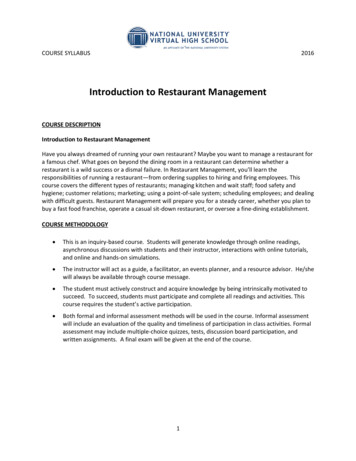

![Index [beckassets.blob.core.windows ]](/img/66/30639857-1119689333-14.jpg)
